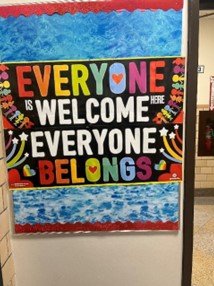Latest Case Study from Fillmore Central School Now Available from NYKids: Leveraging Belongingness to Improve Students’ Experiences
NYKids has been hard at work this year visiting schools throughout the state. As described in a previous blog, for our 20th anniversary study, NYKids is returning to schools we identified as positive outliers in prior NYKids studies (what we call “persistent positive outliers”) as well as those that we identified as typically-performing, yet have risen to positive outlier status (what we call “emergent positive outliers”).
We are excited to announce in this blog that the case study of Fillmore Central School, our first emergent positive outlier in this study, is now available here on our website. Below, we explore some of the major themes we found in Fillmore this spring.
Fillmore Central School Background
 Located in Allegany County, in the southwestern portion of New York State, Fillmore Central School serves a population of just under 600 students, all housed inside a large, PK-12 school building at the center of the town. While Fillmore is a rural school, it is situated only 75 minutes from the cities of Rochester and Buffalo. At Fillmore, educators described deep ties to the community that have been cultivated over generations; many staff members were themselves graduates of the school and personally familiar with the families of students they served.
Located in Allegany County, in the southwestern portion of New York State, Fillmore Central School serves a population of just under 600 students, all housed inside a large, PK-12 school building at the center of the town. While Fillmore is a rural school, it is situated only 75 minutes from the cities of Rochester and Buffalo. At Fillmore, educators described deep ties to the community that have been cultivated over generations; many staff members were themselves graduates of the school and personally familiar with the families of students they served.
Like other rural communities, Fillmore Central School serves, as several educators put it, as the “hub” of the town. Indeed, educators explained how community and family members alike flocked to the campus to take part in its sports, musical performances, and community events, which they emphasized were an important part of students’ experiences in school.
Key Findings
- Developing Well-Rounded Youth
We are trying to prepare life skills for beyond these walls. We want them [students] to be successful as adults, too. So, it’s not just looking at a number on a test. – teacher
Educators at Fillmore articulated a goal of developing young adults who would be ready for life after high school. From this view, success for students was not defined narrowly in only academic terms but was seen as achievable through extracurricular activities such as sports, music, and art. In addition, Fillmore educators emphasized the significance of demonstrating positive behaviors in school, such as respect and resiliency, and viewed these character traits as an important measure of students’ success alongside their academics.
- Building Supportive Relationships with Each Student
It makes me feel good as a parent to know like, we have this amazing group of people in our school that are going to be there to help lift up our kids and support them emotionally and physically. – parent
One way in which educators at Fillmore said they support their students is by developing individual relationships with each student. Teachers explained that they were able to connect with students not only in their classes and across their PK-12 career at Fillmore but also through the range of extracurricular activities offered at the school. In an effort to ensure that all students enjoy a sense of belonging at the school, recently, a Social-Emotional Learning Team was created that pairs staff members with individual students who have been identified as needing additional support.
- Building from Long-Standing Ties in the Community
I actually went to Fillmore as a kid. So starting kindergarten all the way up through, [and then] went off to college to be a teacher. And . . . one of the reasons I became a teacher was because of the school. – teacher
Many educators explained that they not only lived in the district but had grown up there, giving them special insights and connections to the community. According to many, the school served as the “hub” of the community and always drew large crowds for events and activities such as sporting events and musicals. In a rural context where resources were sometimes scant, educators also felt that the school and community often mutually relied on one another to ensure that children and youth were able to have their needs met.
Take-aways:
- Purposefully leverage extracurricular activities as spaces and places to develop respect and resiliency in alignment with NYSED benchmarks.
- Use team belonging strategies to recruit teachers, support staff, food service and bus drivers on a social-emotional learning team.
- Examine and plan to implement a Grow Your Own program to develop a pipeline of home-grown educators.
What’s next?
Read the entire Fillmore Case Study on our website and stay tuned as NYKids will continue to release case studies of emergent and persistent positive outlier schools this summer!
As always, we thank you for your interest in NYKids! Please reach out to us at nykids@albany.edu or follow us on X, Instagram, Facebook, and LinkedIn! We also encourage you to contact us if you are interested in NYKids direct school improvement support this summer.
